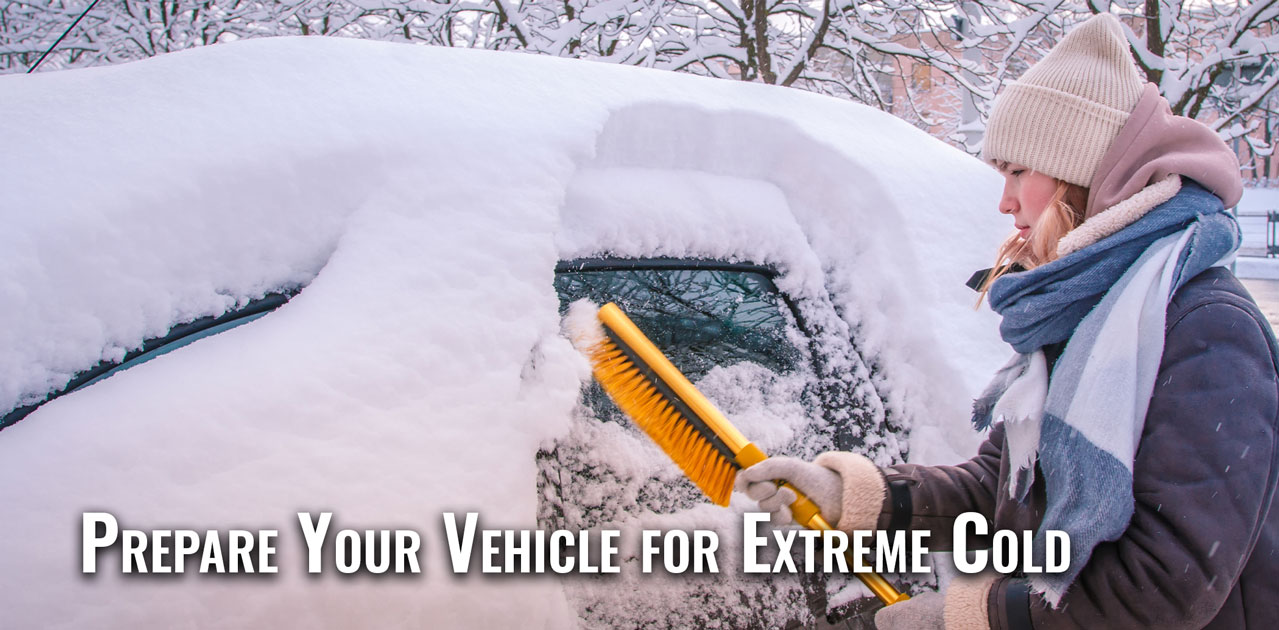While the amount of danger from winter weather varies across the country, nearly all Americans are likely to face some degree of severe winter weather throughout their lives. Winter storms can range from moderate snow over the course of a few hours to a blinding blizzard that lasts for several days. Many winter storms are accompanied by dangerously low temperatures, strong winds, ice, sleet and freezing rain.A primary concern during winter storms and extreme cold is commuting safely. Most businesses, events and activities will only close down during the worst storms or extreme temperatures during winter. As such, it’s vital that vehicles are prepared for winter weather to make commuting in these conditions as safe as possible.
Winterize Your Vehicle
Check or have a mechanic review the following items on your car:
- Antifreeze levels—Ensure these levels are sufficient to avoid freezing.
- Battery and ignition system—This system should be in proper working condition, and all battery terminals should be clean.
- Brakes—Check all brakes for potential damages or wear and tear.
- Exhaust system—Check this system for leaks and crimped pipes, and repair or replace as necessary. Carbon monoxide is deadly and usually gives no warning of its presence.
- Fuel and air filters—Have filters replaced regularly and keep water out of the system by using additives, as well as maintaining a full tank of gas. A full tank will keep the fuel line from freezing.
- Heater and defroster—Ensure that both of these items work properly.
- Lights and flashing hazard lights—Check all lights for potential damages and overall serviceability.
- Oil—Check oil level and weight. Heavier oils congeal at low temperatures and do not lubricate as well.
- Thermostat—Ensure that this item works properly.
- Windshield wiper equipment—Review this equipment for potential damages. Repair any problems and ensure a proper washer fluid level.
- Winter tires—Make sure all tires have adequate tread. All-weather radials are usually adequate for most winter conditions. However, some jurisdictions require vehicles to be equipped with chains or snow tires with studs in winter weather conditions.
Update the emergency kit in your vehicle with these items:
- A shovel
- A windshield scraper and small broom
- A flashlight
- A battery-powered radio
- Extra batteries
- Water
- Non-perishable food items
- Matches
- Extra hats, socks and mittens
- A first-aid kit with a pocket knife
- Any necessary medications
- Blankets
- A tow chain or rope
- Road salt and sand
- Booster cables
- Emergency flares
- Fluorescent distress flags
If You Are Stranded in a Vehicle
If a blizzard
traps you in the car:
- Pull off the highway. Turn on the hazard lights and hang a distress flag from the radio antenna or window.
- Remain in your vehicle where rescuers are most likely to find you. Do not set out on foot unless you can see a building close by where you know you can take shelter. Be careful—distances are distorted by blowing snow. A building may seem close, but be too far to walk to in deep snow.
- Run the engine and heater for about 10 minutes each hour to keep warm. When the engine is running, open a downwind window slightly for ventilation and periodically clear snow from the exhaust pipe. This will protect you from carbon monoxide poisoning.
- Exercise to maintain your body heat, but avoid overexertion. In extreme cold, use road maps, seat covers and floor mats for insulation. Huddle with passengers and use your coat for a blanket.
- Take turns sleeping. One person should be awake at all times to look for rescue crews.
- Eat regularly and drink ample fluids to avoid dehydration, but avoid caffeine and alcohol.
- Be careful not to waste battery power. Balance electrical energy needs—the use of lights, heat and radio—with supply.
- Turn on the inside light at night so work crews or rescuers can see you.
- If stranded in a remote area, stomp large block letters in an open area spelling out “HELP” or “SOS” and line the letters with rocks or tree limbs to attract the attention of rescue personnel who may be surveying the area by air.
- Leave the car and proceed on foot—if necessary—once the blizzard passes.
Familiarize yourself with these terms to help identify winter storm hazards:
- Freezing rain—This is rain that freezes when it hits the ground, creating a coating of ice on roads, walkways, trees and power lines.
- Sleet—This is rain that turns to ice pellets before reaching the ground. Sleet also causes moisture on roads to freeze and become slippery.
- Winter weather advisory—This means that winter weather conditions are expected to cause significant inconveniences and may be hazardous. When caution is used, these situations should not be life-threatening.
- Winter storm watch—This means that a winter storm is possible in your area. Tune in to National Oceanic and Atmospheric Administration Weather Radio, commercial radio or local television for more information.
- Winter storm warning—This means that a winter storm is occurring or will soon occur in your area.
- Blizzard warning—This means that sustained winds or frequent gusts (35 mph or greater) and considerable amounts of falling or blowing snow (reducing visibility to less than a quarter mile) are expected to prevail for a period of three hours or longer.
- Frost/freeze warning—This means that below-freezing temperatures are expected.
Marshfield Insurance Agency is committed to helping you and your loved ones stay safe when disaster strikes. For additional risk management guidance, contact us today.

